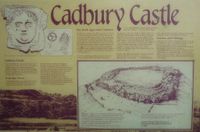Cadbury Castle
Cadbury Castle is Somerset's largest hill fort, from which the Barony of North Cadbury (Cadeberie - Cada's Fort) takes its name. Cadbury Castle also known as Camelot Castle, is a bronze and iron age hillfort in the civil parish of South Cadbury.
This ancient site is deeply connected with the legendary King Arthur. The hill is the most probable site of King Arthur's principle court famously called Camelot.
It is also be said by an ancient writer to have been one of the stations of the Round Table of King Arthur. The following account of this singular fraternity will be interesting to the reader: "This Round Table was kept at several places, especially at Caerleon in Monmouthshire, at Winchester, and at Camalet in Somersetshire."
Excavations at Cadbury Castle
In June 1913 trial excavations were held on Cadbury Castle. The excavations took place in the south west corner of the hill said by some to be the 'Camelot' of King Arthur. Six men were employed in the excavation work. Many pieces of pottery of the Romano-British era were found as well as evidence of walls and ramparts and a small child's skeleton. The work was carried out on behalf of the Somerset Archaeological and Natural History Society. More recent excavations of the site were led in the 1960s to 1970 by archaeologist Leslie Alcock and since 1992 by the South Cadbury Environs Project.
Camelot Finds
Among the excavations a vast number of unusual findings were found here, especially from the assumed time of King Arthur around the fifth and sixth century. This indicates that then a very rich and powerful personage had his seat at Cadbury Castle.
The book 'By South Cadbury is that Camelot...' Excavations at Cadbury Castle 1966-70 is an excellent reference about the excavations at Cadbury Castle in the years 1966-1970. This book of great archaeological and historical importance was published by Thames and Hudson Ltd in 1972 and it is interesting to note that it was also published in Germany by Gustav Lübbe Verlag, Bergisch Gladbach in 1974.
